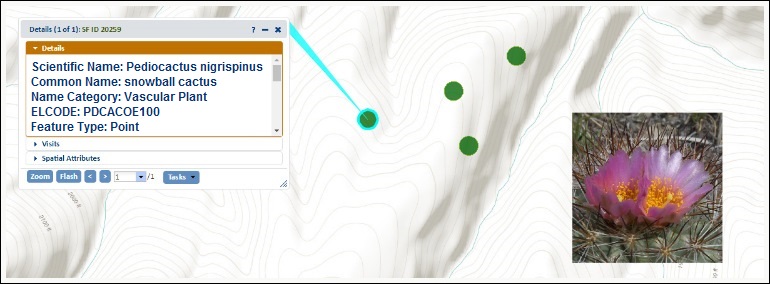
Data Products and Requests
Products
The WA Natural Heritage Program (WNHP) maintains the most comprehensive database and expertise on rare plants and rare/high quality ecological communities in the state. Our program manages spatial and tabular information for 371 rare vascular plants, 59 rare nonvascular species, and 1,183 rare and high-quality common ecological communities. Currently, the Natural Heritage Information System contains more than 7,000 records for these priority features. This information is available in a variety of formats.
Technical Reports - Available for download on the Reports pages.
• Species
Species Lists - Endangered, Threatened and Sensitive lists for vascular plants, nonvascular species, and animals are found on the Species Lists page.
Ecological Communities Lists
County Lists
• Vascular and nonvascular species (Excel)
• Rare/high-quality ecological communities (Excel)
GIS Datasets
• Locations of Rare Plants and Rare/High-quality Ecosystems - More than 7,000 site-specific records of Washington's most significant elements of biodiversity. The data are downloadable as two distinct datasets: Current data (WNHP Element Occurrences – Current) and historical data (WNHP Element Occurrences – Historical). Rare plant locations are buffered; download the EO metadata for details.
• Oaks and Grasslands of the Puget Trough Ecoregion - Oak and mixed oak communities, native and non-native grasslands and shrublands.
• Ecological Systems of Washington (for EIA use) - Dataset is modified from NatureServe's map of Ecological Systems. Modification includes the addition of two fields for use in the Ecological Integrity method, Land Cover type and Land Use category.
• Ecoregions of the Pacific Northwest - Based on EPA’s Level III ecoregions, modified in consultation with The Nature Conservancy, Washington Department of Fish & Wildlife, and other conservation partners.
• Washington DNR GIS data - Publicly available datasets from programs within the Department of Natural Resources.
Web Viewers
Information Requests
For site-specific information, you may request a Project Area Report by submitting an Information Order Form. The report will indicate whether or not a Natural Heritage feature is known to occur within your project area and, if so, will include scientific and common name, federal and state status and a list of townships, ranges and sections in which the feature(s) is found. You may request this information for your project area only or a specified distance surrounding your project, e.g. a one mile radius.
Environmental Review
WNHP data is commonly used in the development and evaluation of projects that must comply with SEPA and/or NEPA requirements. Additionally, our staff review and comment on SEPA and NEPA documents during the environmental review process, especially if it has been determined that the proposed action may impact rare plants or rare/high quality ecological communities.
Additional Resource
Submitting Data to the Natural Heritage Program
Our program relies on information from outside contributors to continue to maintain the most complete database of rare plants and ecological communities in Washington. If you have site specific information for any of the species on our rare plant or nonvascular lists or information on rare/high quality ecological communities, choose the appropriate form below and submit your data (our program mailing address and email are found on the upper right-hand side of this page).
Species
• Rare Plant Sighting Form (PDF, Word form)- Contribute your sightings of rare plants; for identification verification, refer to our online Field Guide to the Rare Plants of Washington.
Ecological Communities
Additional Resources:

